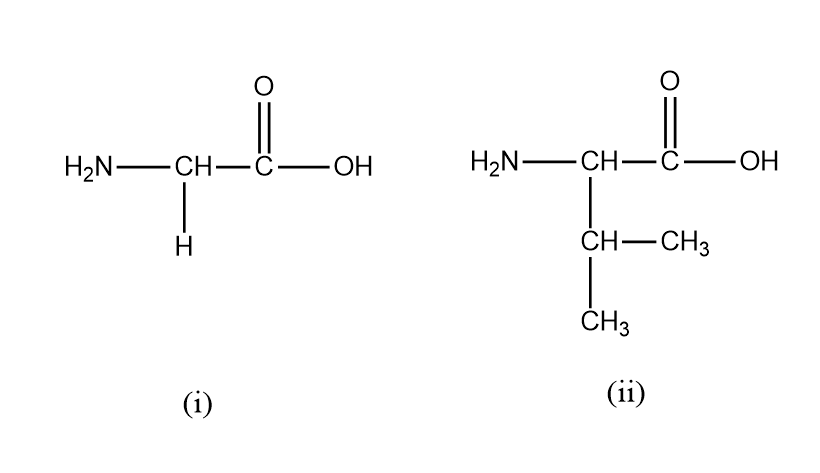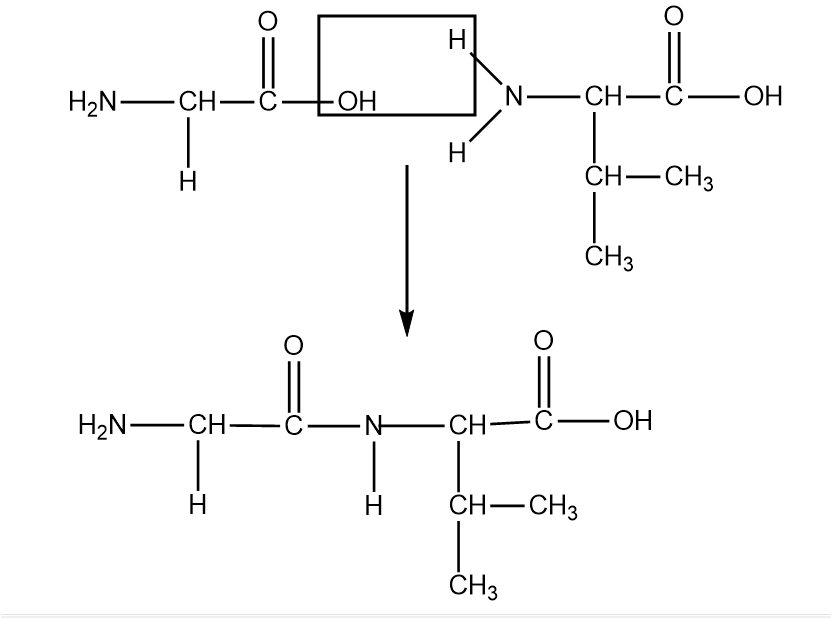
Fig shows two amino acids, glycine and valine. Use the space below to make a drawing to show what happens when these two molecules join together to form a dipeptide.
(A) Glycine
(B) valine


Answer
424.2k+ views
Hint :An amino acid is made up of an amino group, a carboxyl group and an R group that is specific to the amino acid. The R group is what determines the characteristics such as the pH of each amino acid.
Complete Step By Step Answer:
The functional group is the carboxyl group and the amino acid. The functional group are the carboxyl groups and the amine group from the amino acids. There are twenty amino acids and the bonds that form between them are known as peptide bonds.
Glycine and valine are two such amino acids that can be joined through a peptide bond. The structure of each are as follows:

In Glycine, the R group here is H under the central carbon. In Valine the R group here is
Different amino acids can be joined together to make a protein. The order of the amino acids determines which protein will be made.
Note :
When two amino acids are joined together, a dipeptide is formed. A special chemical bond called a peptide bond holds together two amino acids. Protein usually consists of multiple amino acids that are held together by peptide bonds. So, the bigger the protein, the more amino acids and peptide bonds there are.
Complete Step By Step Answer:
The functional group is the carboxyl group and the amino acid. The functional group are the carboxyl groups and the amine group from the amino acids. There are twenty amino acids and the bonds that form between them are known as peptide bonds.
Glycine and valine are two such amino acids that can be joined through a peptide bond. The structure of each are as follows:

In Glycine, the R group here is H under the central carbon. In Valine the R group here is
Different amino acids can be joined together to make a protein. The order of the amino acids determines which protein will be made.
Note :
When two amino acids are joined together, a dipeptide is formed. A special chemical bond called a peptide bond holds together two amino acids. Protein usually consists of multiple amino acids that are held together by peptide bonds. So, the bigger the protein, the more amino acids and peptide bonds there are.
Latest Vedantu courses for you
Grade 11 Science PCM | CBSE | SCHOOL | English
CBSE (2025-26)
School Full course for CBSE students
₹41,848 per year
Recently Updated Pages
Master Class 9 General Knowledge: Engaging Questions & Answers for Success

Master Class 9 English: Engaging Questions & Answers for Success

Master Class 9 Science: Engaging Questions & Answers for Success

Master Class 9 Social Science: Engaging Questions & Answers for Success

Master Class 9 Maths: Engaging Questions & Answers for Success

Class 9 Question and Answer - Your Ultimate Solutions Guide

Trending doubts
State and prove Bernoullis theorem class 11 physics CBSE

Who built the Grand Trunk Road AChandragupta Maurya class 11 social science CBSE

1 ton equals to A 100 kg B 1000 kg C 10 kg D 10000 class 11 physics CBSE

State the laws of reflection of light

One Metric ton is equal to kg A 10000 B 1000 C 100 class 11 physics CBSE

Difference Between Prokaryotic Cells and Eukaryotic Cells




